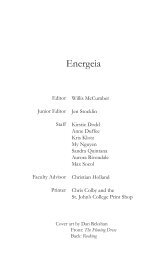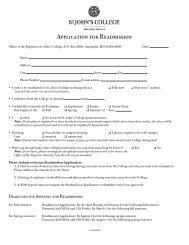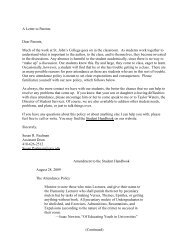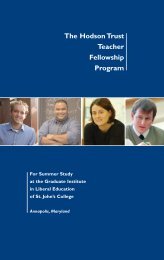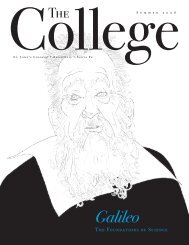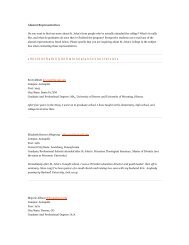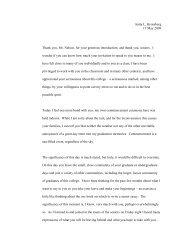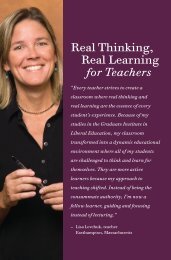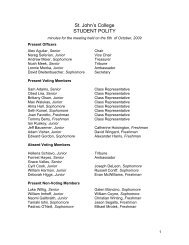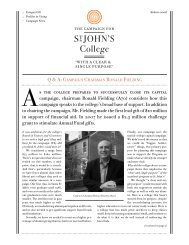Magazine - summer 03 - St. John's College
Magazine - summer 03 - St. John's College
Magazine - summer 03 - St. John's College
Create successful ePaper yourself
Turn your PDF publications into a flip-book with our unique Google optimized e-Paper software.
{Culture and Context}<br />
21<br />
“The Nazis tried to wipe them out. The registry<br />
brings them back.”<br />
<strong>St</strong>ephen Vitto, A85<br />
“The building itself is an artifact,” he says. “It’s made of the brick<br />
and steel of industrialization, with jagged lines of lights. There’s a<br />
lot of gray and black and an emphasis on poignant photographs.<br />
There are false doors, some parts are dark, some are cramped. Its<br />
layout is meant to be confusing, to give you some sense for the experience<br />
of the Holocaust: once the knock on the door came, people<br />
didn’t know what was going to happen to them.”<br />
The Holocaust Museum is an exemplary work of museum craft,<br />
says Murphy. “You hate to say it’s your favorite museum, because of<br />
the subject matter, but in terms of a museum that gets its point<br />
across, the Holocaust Museum is the finest museum that I’ve ever<br />
been to. It tells the story without devolving into mere voyeurism. It<br />
involves you from the minute you walk into the door. The skill of the<br />
people who put that together is unbelievable.”<br />
Vitto considers himself<br />
fortunate to have witnessed<br />
that skill first-hand. He<br />
began working at the Holocaust<br />
Museum three years<br />
before there was a Holocaust<br />
Museum, after answering an<br />
ad at George Washington<br />
University (where he was<br />
working on a master’s degree<br />
in history) for entry-level<br />
library work. At the beginning,<br />
he did a lot of cataloguing<br />
and answered reference<br />
questions. Early on, he says,<br />
the library staff was uncertain<br />
of how the collections<br />
would be used: by historians?<br />
scholars? for personal<br />
research? As library use<br />
grew, they learned that about<br />
90 percent of visitors were<br />
survivors and their families,<br />
a group that often formed<br />
lines of 20 to 30 people at the<br />
reference desk looking for<br />
personal information.<br />
By the time the library<br />
opened in April 1993, Vitto<br />
and a colleague had developed<br />
an expertise in finding<br />
historical information particular<br />
to the needs of survivors.<br />
Vitto, for instance,<br />
gary pierpoint<br />
developed a reading knowledge of Hebrew, Yiddish, German,<br />
and all Slavic languages. As the librarians learned to find their<br />
way around ghetto lists, transports, and work details, they began<br />
to focus their work on building a survivors’ registry, using as<br />
their foundation a registry started in 1981 as a project of the<br />
American Gathering of Jewish Holocaust Survivors.<br />
Today, the registry database contains information on approximately<br />
180,000 Holocaust survivors and their family members<br />
worldwide and handles 34,000 requests annually. Vitto’s work<br />
at the museum is what he describes as a perfect mix of researching<br />
documents for the registry and working with survivors and<br />
their families. He talks about the registry’s relationship to one<br />
of the museum’s most poignant exhibits, the Tower of Faces.<br />
This three-story tall exhibition shows 1,500 photographs taken<br />
over a 50-year period in<br />
Ejszyszki, a shtetl in Lithuania.<br />
The photographs capture<br />
the everyday lives of<br />
Ejszyszki’s 4,000 Jews<br />
before the Holocaust, with<br />
pictures from weddings and<br />
family reunions, school and<br />
the beach, graduations and<br />
bar mitzvahs. On two days in<br />
September 1941, all but 29 of<br />
the 4,000 Ejszyszki Jews<br />
were killed by German death<br />
squads.<br />
For Vitto, the photographs<br />
run seamlessly into his work<br />
with the registry and explain<br />
why he finds his work so<br />
fulfilling. “This is completely<br />
what my work is about,” he<br />
says. “The Nazis tried to wipe<br />
them out. The registry brings<br />
them back.” x<br />
At the Holocaust Museum,<br />
<strong>St</strong>even Vitto has a daily<br />
reminder of the importance<br />
of his work: the faces of<br />
Jews from a shtetl in<br />
Lithuania where all but<br />
29 of the 4,000 Jews were<br />
killed by German death<br />
squads in 1941.<br />
{ The <strong>College</strong> • <strong>St</strong>. John’s <strong>College</strong> • Fall 2004 }




